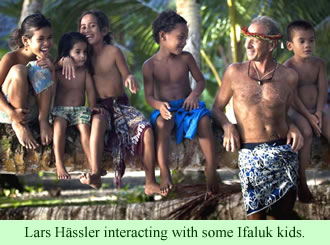The best news about the really isolated peaceful societies is that they are still remote, still quiet, and still able to persist in their ways, despite intrusions of the modern world. So a blog report by a visitor to Ifaluk Island is welcome due to the way it confirms that the people there thrive, their traditional customs persist, and life for them is still good.
 Last week, photographer Jennifer Davidson posted to her blog “A Patchwork Path” an entry about her visit to Ifaluk Island and, 175 miles to the east of it, Satawal Island. Both are in the Yap State of the Federated States of Micronesia. She provides some wonderful photos and interesting comments about the social life and economies of the two places. She doesn’t make it clear when she visited them—presumably on a recent cruise—but she does convey the welcoming spirit of both.
Last week, photographer Jennifer Davidson posted to her blog “A Patchwork Path” an entry about her visit to Ifaluk Island and, 175 miles to the east of it, Satawal Island. Both are in the Yap State of the Federated States of Micronesia. She provides some wonderful photos and interesting comments about the social life and economies of the two places. She doesn’t make it clear when she visited them—presumably on a recent cruise—but she does convey the welcoming spirit of both.
Even though the two islands are quite similar, she does point out some differences. The waters around Satawal, she indicates, have been over-fished, depleted of not only their large fish but much of the rest of the marine life. The people of Satawal use their sea-going canoes to visit other uninhabited islands and bring back foods. Ifaluk is doing better, Davidson reports, with fish and mollusks inhabiting the surrounding reefs. Both islands have about 500 people.
The author observed during her visits to the two places how the islanders cherish their traditions, though manifestations of outside culture are present, remote as they are. Girls sing popular songs, boys wear modern clothing, and some of the men use fiberglass canoes. Though traditional boats still far outnumber modern ones, she sees some outboard motors. She does not make it clear which of the two islands has modernized more, or has preserved its traditional culture better.
The skipper of a yacht that visited Ifaluk two years ago, Lars Hässler, mentioned that he had observed no fiberglass boats or outboard motors on the island. Either Ifaluk has modernized a bit since 2012 or Ms. Davidson saw them on Satawal. She doesn’t make that clear in her blog entry.
Apparently, the occasional cruise boat passengers are greeted on these islands by displays of traditional dances in which most of the islanders participate. Ms. Davidson writes evocatively, describing the way the people dust themselves with turmeric to give their skins a richer yellow luster. She adds, “the rhythms of chanting and movement range from almost meditative to humming with vibrant energy.” A tropical downpour only added to the performance on Ifaluk. Girls and women ranging in age from 4 or 5 through their 70s participated. As the rain grew heavier, the energy of the dancing only increased.
She writes that as she walked through the village, people frequently invited her into their homes and told her about themselves and their lives. They asked her about herself. They appeared to be happy, though she recognizes the temptation to overly romanticize the existence of people on an idyllic island.
Several photos of the dancing on Ifaluk, including a really charming one of two young girls performing with the adults, complement her story about the two islands that she was privileged to visit briefly.